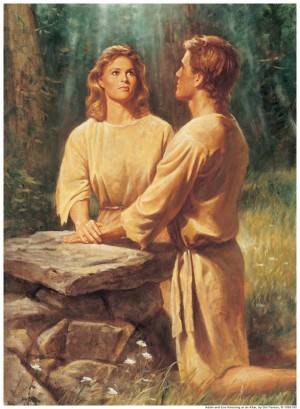Encyclopedia of Mormonism summarizes Eve’s role in the Fall as follows:
Satan was present to tempt Adam and Eve, much as he would try to thwart others in their divine missions: “and he sought also to beguile Eve, for he knew not the mind of god, wherefore he sought to destroy the world” (Moses 4:6). Eve faced the choice between
 selfish ease and unselfishly facing tribulation and death (Evidences and Reconciliations, by John A. Widtsoe, page 193). As befit her calling, she realized that there was no other way and deliberately chose mortal life so as to further the purpose of god and bring children into the world. (s.v. “Eve”)
selfish ease and unselfishly facing tribulation and death (Evidences and Reconciliations, by John A. Widtsoe, page 193). As befit her calling, she realized that there was no other way and deliberately chose mortal life so as to further the purpose of god and bring children into the world. (s.v. “Eve”)
Elder Dallin H. Oaks taught about the vital contribution of Eve in partaking of the fruit and of the difference between transgression and sin.
It was Eve who first transgressed the limits of Eden in order to initiate the conditions of mortality. Her act, whatever its nature, was formally a transgression but eternally a glorious necessity to open the doorway toward eternal life. Adam showed his wisdom by doing the same. And thus Eve and “Adam fell that men might be” (2 Ne. 22:25).
Some Christians condemn Eve for her act, concluding that she and her daughters are somehow flawed by it. Not the Latter-day Saints! Informed by revelation, we celebrate Eve’s act and honor her wisdom and courage in the great episode called the Fall (see Bruce R. McConkie, “Eve and the Fall,” Woman, Salt Lake City: Deseret Book Co., 1979, pp. 67–68). Joseph Smith taught that it was not a “sin,” because god had decreed it (see The Words of Joseph Smith, ed. Andrew F. Ehat and Lyndon W. Cook, Provo, Utah: Religious Studies Center, Brigham young University, 1980, p. 63). Brigham young declared, “We should never blame Mother Eve, not the least” (in Journal of Discourses, 13:145). Elder Joseph Fielding Smith said: “I never speak of the part Eve took in this fall as a sin, nor do I accuse Adam of a sin. . . . This was a transgression of the law, but not a sin . . . for it was something that Adam and Eve had to do!” (Joseph Fielding Smith, Doctrines of Salvation, comp. Bruce R. McConkie, 3 vols., Salt Lake City: Bookcraft, 1954–56, 1:114–15).
This suggested contrast between a sin and a transgression reminds us of the careful wording in the second article of faith: “We believe that men will be punished for their own sins, and not for Adam’s transgression” (emphasis added). It also echoes a familiar distinction in the law. Some acts, like murder, are crimes because they are inherently wrong. Other acts, like operating without a license, are crimes only because they are legally prohibited. Under these distinctions, the act that produced the Fall was not a sin—inherently wrong—but a transgression—wrong because it was formally prohibited. These words are not always used to denote something different, but this distinction seems meaningful in the circumstances of the Fall. (“The great Plan of Happiness,” 73; part of this is also quoted in the Old Testament Gospel Doctrine Teacher’s Manual, pp. 15–16)
Another question that might come up, based on the above quotes that Eve made a deliberate, unselfish choice, is how to deal with Paul’s statement that Eve was deceived.
14 And Adam was not deceived, but the woman being deceived was in the transgression. (1 Timothy 2:14)
However, the Pearl of great Price indicates that Satan “sought to beguile Eve,” in other words, “tried” to deceive Eve, thus implying that he was not entirely successful.
6 And Satan put it into the heart of the serpent, (for he had drawn away many after him,) and he sought also to beguile Eve, for he knew not the mind of god, wherefore he sought to destroy the world. (Moses 4:6)
It may be that Satan did indeed deceive Eve in many ways, but “sought to” and failed to beguile her in the most important aspect of the situation, whether or not to remain in the garden of Eden or to partake of the fruit and thus bring children into the world to further the Father’s plan. Whatever the case, we will probably have to wait until we get a chance to talk to Eve herself, perhaps during the Millennium, for the complete account. There could be many ways in which she was deceived. Perhaps in the sense of not believing that mortality would be so difficult at times. Perhaps she had no idea what it would be like to care for twenty or thirty sick children when they all had the flu! Maybe she was deceived into thinking that old age with its attendant pains and disabilities would not be at all difficult. Actually, she couldn’t have understood these physical struggles because she had no basis on which to judge, since she and her husband were not yet mortal, even though they had physical bodies at this point.
Adam and Eve Bear Testimony of the Benefits of the Fall
Sometime after they were cast out of the garden of Eden, both Adam and Eve bore testimony of the benefits of the Fall and rejoiced that it had taken place and in the opportunities that it provided.
10 And in that day Adam blessed god and was filled, and began to prophesy concerning all the families of the earth, saying: Blessed be the name of god, for because of my transgression my eyes are opened, and in this life I shall have joy, and again in the flesh I shall see god.
11 And Eve, his wife, heard all these things and was glad, saying: Were it not for our transgression we never should have had seed, and never should have known good and evil, and the joy of our redemption, and the eternal life which god giveth unto all the obedient. (Moses 5:10–11)
As a result of the Fall, Adam and Eve and all their posterity became subject to both physical and spiritual death. Physical death is the separation of the mortal body from the spirit which gives it life. It prepares the way for resurrection, which is provided to all by the Atonement of Christ (1 Corinthians 15:22). Spiritual death means being cut off from the direct presence of god. It does not mean being completely cut off from any communication with Him or from any influence by Him. The term for completely dying as far as any spirituality is concerned, thus being cut off completely from god and His influence, is “second death” (Jacob 3:11; Alma 12:16, 32; 13:30).
In summary, vital blessings and benefits came as a result of the Fall. The Fall and the Atonement work together. The Fall was a planned step in our Father’s plan for us. Heaven was not caught off guard or surprised by it (2 Nephi 2:24). We hold Adam and Eve in highest esteem for their unselfish role in instigating the Fall. The benefits of the Fall include:
1. Adam and Eve obtained mortal physical bodies.
2. Adam and Eve were able to have children, which means that we could come to earth.
3. Physical death came with its consequent resurrection resulting in immortality.
4. Knowledge of good and evil became available.
5. Spiritual death (being cut off from the direct physical presence of god) came, with the accompanying opportunities to walk by faith and prayer, scripture study, following the prophets, and so forth.
6. Misery and woe came upon mankind as part of our eternal education.
7. The Atonement of Christ came into play, overcoming the effects of personal sin through repentance and living the gospel of Jesus Christ.
8. The ground was cursed, causing Adam, Eve, and all of us to have to work, thus receiving the blessings and growth that accompany labor.
9. True joy became available.
10. The opportunity to grow and progress toward exaltation came to all. In other words, the Fall was the next step in the plan of happiness, bringing all of us the opportunity to continue progressing toward obtaining a glorified, resurrected physical body, and truly becoming like Heavenly Father.
Learn more about the fall of Adam and Eve at the official site of The Church of Jesus Christ of Latter-day Saints (inadvertently called by friends of other faiths as the “Mormon Church”).
Source:
D. Ridges, The Fall, (Springville, Utah: Cedar Fort, Inc., 2010), 25-37.



